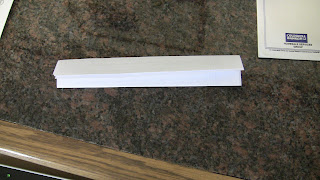SIZE - I have found that 14 gauge electric fence wire works well as an armature for most sizes of sculpture. I now sculpt most of my figures in the 10-14" size and this size wire works well as an armature without the need to twist wire or add extra support as long as you are doing a simple POSE.
SIMPLE ARMATURE
This is the outline of a simple 14 gauge armature. It consists of three parts which are foil taped together along the spine of the figure. This armature will hold most figures just fine until you start doing extreme poses or reach the 14" height. Please note that the leg wires will need to be longer to insert into a base.
This 8" tall fairy is built on this simple armature.
THE AUGMENTED SIMPLE ARMATURE
This is an augmented simple armature we laid out on our proportion chart in a previous post. The wire parts are the same as the simple armature but two brass tubes have been slipped over the leg wires for more support. (If the figure is holding another figure, the arms can be covered with tubing as well to support the next figure.) These tubes run all the way to the bend at the neck before the hip bends are made in the tubing/wire.
 | This figure uses an augmented simple armature to add strength to the legs and hips. | ||||||
Here are three examples of the simple armature used to do different designs:
This figure is built on a simple wire armature. She is seated and has a soft cloth body so the only stress on the clay and the armature is in the head/chest area and the lower arms and legs. The simple armature can easily support the stress in these areas.

This figure is a good representation of a standing figure which would use a simple armature. He has a sculpted body but the body is then covered with a costume. He is about 14" tall so the simple armature will work just fine. The thing to keep in mind with this figure is that he may crack at the knees, hips, and shoulders from stress with an unsupported simple armature. To avoid this, he has control joints cut into his body at those points to allow the internal stress to be released at the joints rather than crack the figure. A control joint is much like the joint which masons place in sidewalks so the slab will crack in squares rather than a random pattern when it freezes and thaws. The control joints are then covered with the costuming.
This figure is also a standing figure but is nude so she needs lots of rigidity inside her so she will not crack. The simple armature will work on her but it needs to be augmented once the size of the figure passes the 10" tall mark.
This is the extreme use of the simple armature. In this case the armature supports a figure but we add a rigid rod which passes through the figure to support the figure above it. In this case, the rod bypasses the lower figure so the stress of the upper figure does not impact the body of the lower figure.
This is the almost finished image of the "bypassed simple armature" in use.
Hope this answers a few questions and opens your minds to a lot more unanswered ones. Next time we will look at a more advanced armature.
Have a great day!





















































